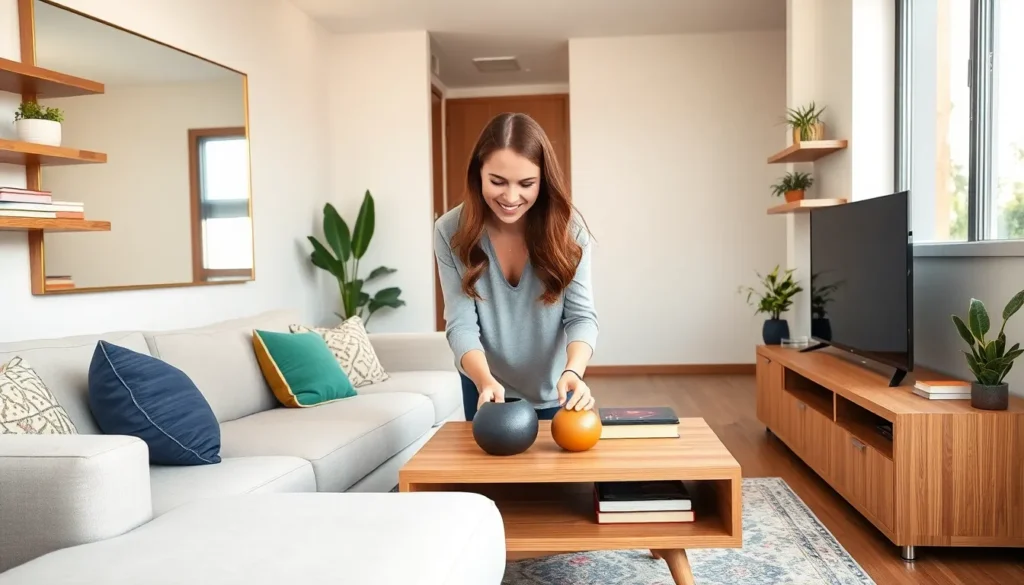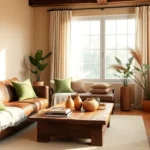Living in a small apartment doesn’t mean sacrificing style or comfort in your living room. We’ve all faced the challenge of making a tiny space feel both functional and inviting while avoiding that cramped, cluttered look that makes you want to escape to the nearest coffee shop.
Small living rooms can become your favorite space when you apply the right design strategies. We’re talking about clever furniture choices that pull double duty clever storage answers that hide in plain sight and visual tricks that make your room appear twice its actual size.
Whether you’re dealing with a studio apartment or a compact one-bedroom we’ve gathered the most effective small living room ideas that actually work in real life. These aren’t Pinterest-perfect concepts that fall apart the moment you try to live in them – they’re practical answers that maximize every square inch without breaking your budget.
Maximize Your Space With Multi-Functional Furniture
Smart furniture choices can transform your cramped living room into a spacious haven. We’ve discovered that pieces serving dual purposes eliminate clutter while adding style to apartment small living room spaces.
Choose Storage Ottomans and Coffee Tables
Storage ottomans work overtime as seating, footrests, and hidden compartments for blankets, magazines, and remote controls. We recommend selecting ottoman designs with removable tops that reveal spacious interiors measuring at least 15 inches wide. Rectangle shapes fit better in narrow apartments than round options, while upholstered versions in neutral colors like beige or gray blend seamlessly with existing decor.
Coffee tables with built in shelves or drawers provide essential storage without occupying additional floor space. Lift top models reveal hidden compartments perfect for storing board games, electronics, or seasonal items. Glass topped tables with lower shelving create visual lightness while offering display space for books and decorative objects.
Nesting tables offer flexibility when entertaining guests but tuck away completely when not needed. We’ve found that three piece sets in matching finishes maximize utility, with the smallest table sliding perfectly under the largest when stacked.
Invest in Expandable Dining Tables
Expandable dining tables solve the challenge of accommodating guests in apartment small living room layouts without permanent space sacrifice. Drop leaf designs fold down to console width during regular use but extend to seat six people for dinner parties. We suggest measuring your room carefully to ensure expanded tables leave at least 36 inches of walking space around all sides.
Wall mounted drop down tables attach directly to walls and fold completely flat when not in use. These space saving answers work exceptionally well in studio apartments where every square foot counts. Butterfly leaf mechanisms operate smoothly and store extension pieces within the table base itself.
Round expandable tables work better in square rooms, while rectangular versions suit long narrow spaces. Pedestal bases eliminate corner legs that create obstacles in tight quarters, and we’ve noticed they accommodate more chairs around the perimeter.
Select Sofa Beds for Guest Accommodation
Sofa beds eliminate the need for separate guest rooms while providing comfortable daily seating for apartment small living room areas. Memory foam mattresses in modern convertible sofas offer superior comfort compared to traditional spring mechanisms. We recommend testing the conversion process in stores to ensure smooth operation and reasonable setup time.
Sectional sofa beds maximize seating capacity while converting to queen size sleeping surfaces. L shaped configurations work particularly well in corner placements, creating defined conversation areas during the day. Storage compartments built into sectional bases hold bedding and pillows out of sight.
Futon style options cost less than traditional sofa beds but provide firmer sleeping surfaces that some guests prefer. Japanese inspired designs in low profile frames save visual space while offering clean lines that complement minimalist apartment decor. We’ve found that higher quality futon mattresses made from memory foam or innerspring construction offer better comfort than basic cotton filled versions.
Create the Illusion of Space With Strategic Color Choices

Smart color selections can dramatically transform your small apartment living room from cramped to spacious. We’ll explore proven techniques that make compact spaces feel larger and more inviting through strategic color applications.
Use Light and Neutral Color Palettes
Light-colored walls and floors create an immediate sense of openness in small living rooms. Neutral tones like beige, cream, and pale gray reflect natural light more effectively, making your space feel larger and brighter throughout the day. We recommend painting walls in soft whites or warm off-whites to maximize the light-reflecting properties of your room.
Flooring choices also play a crucial role in expanding visual space. Light hardwood, pale laminate, or cream-colored carpeting helps maintain the airy feeling created by neutral wall colors. Monochromatic schemes using various shades of the same neutral color family create seamless visual flow that eliminates visual breaks and makes your living room appear more expansive.
Add Pops of Color Through Accessories
Vibrant accents through throw pillows, rugs, and vases introduce personality without overwhelming your small space. Colorful accessories allow you to change your room’s mood seasonally while maintaining the spacious foundation created by neutral backgrounds. We suggest limiting bold colors to two or three complementary shades to avoid visual chaos.
Strategic placement of colorful elements draws the eye around the room, creating visual interest and movement. Bright artwork, colorful books displayed on floating shelves, and patterned textiles add character while keeping the overall space feeling open. Removable accessories also offer flexibility to update your decor without major renovations or important expense.
Paint Accent Walls to Add Depth
Painting one wall in a deeper shade creates visual depth and the illusion of a larger space. This technique draws the eye toward the accent wall, making the room appear to extend beyond its actual boundaries. We recommend choosing the wall furthest from the main entrance or the wall behind your seating area for maximum impact.
Color selection for accent walls requires careful consideration of your room’s lighting and existing decor. Rich blues, deep greens, or warm charcoal create dramatic contrast against lighter walls while maintaining sophistication. The accent wall technique works particularly well in rectangular living rooms where the shorter wall becomes the focal point, visually widening the entire space.
Utilize Vertical Space for Storage and Decor
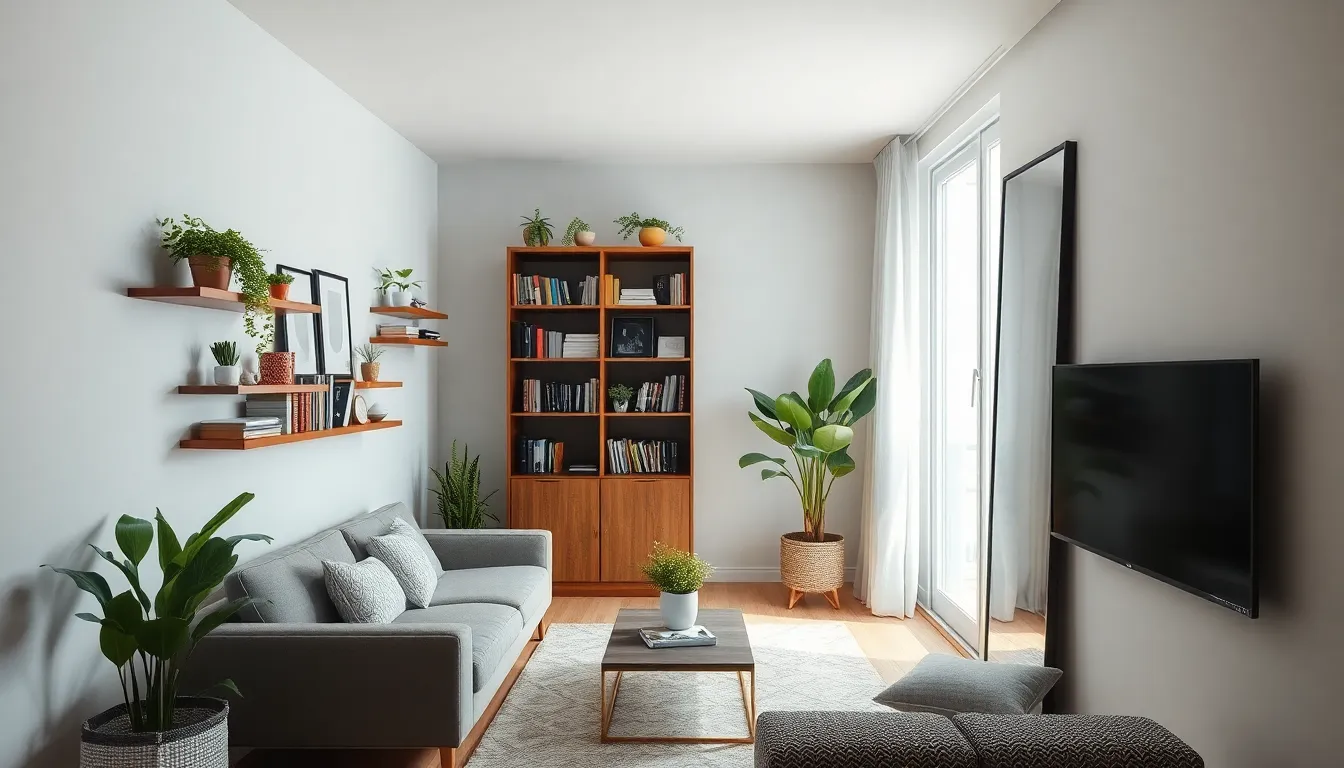
Moving beyond color strategies, we can maximize our small apartment living room’s potential by thinking upward. Vertical space transforms cramped quarters into organized, visually appealing areas that feel surprisingly spacious.
Install Floating Shelves and Wall-Mounted Units
Floating shelves keep our floors clear while creating essential storage that makes rooms feel more spacious. We recommend choosing materials that complement existing decor to maintain visual harmony throughout the space. Wall-mounted units work particularly well above sofas or in corners where floor space is premium real estate.
These installations eliminate the bulk of traditional furniture legs and bases. Mounting units directly to walls creates an airy feeling that’s crucial in compact living rooms. We can display books, plants, and decorative objects without sacrificing valuable square footage below.
Hang Artwork and Mirrors at Eye Level
Artwork and mirrors positioned at eye level create balance that makes rooms appear larger when done correctly. We should mount pieces approximately 57 to 60 inches from the floor to achieve this professional gallery look. Strategic mirror placement reflects natural light and creates the illusion of additional windows.
Large mirrors work especially well opposite windows to bounce light throughout the space. We can also create gallery walls that draw attention upward without overwhelming our small living room. Grouping smaller pieces together adds visual interest while maintaining the eye level principle.
Use Tall Bookcases to Draw the Eye Upward
Tall bookcases visually elongate rooms while adding storage without cluttering floor space. We recommend selecting narrow, floor-to-ceiling units that maximize vertical real estate. These pieces create the illusion of higher ceilings, making our apartment living room feel more expansive.
Styling these bookcases with a mix of books, decorative objects, and plants prevents them from appearing too uniform. We can alternate heavy and light items to create visual rhythm that guides the eye naturally upward. This technique transforms utilitarian storage into attractive focal points that enhance our small space’s overall design.
Optimize Natural Light to Open Up Your Living Room
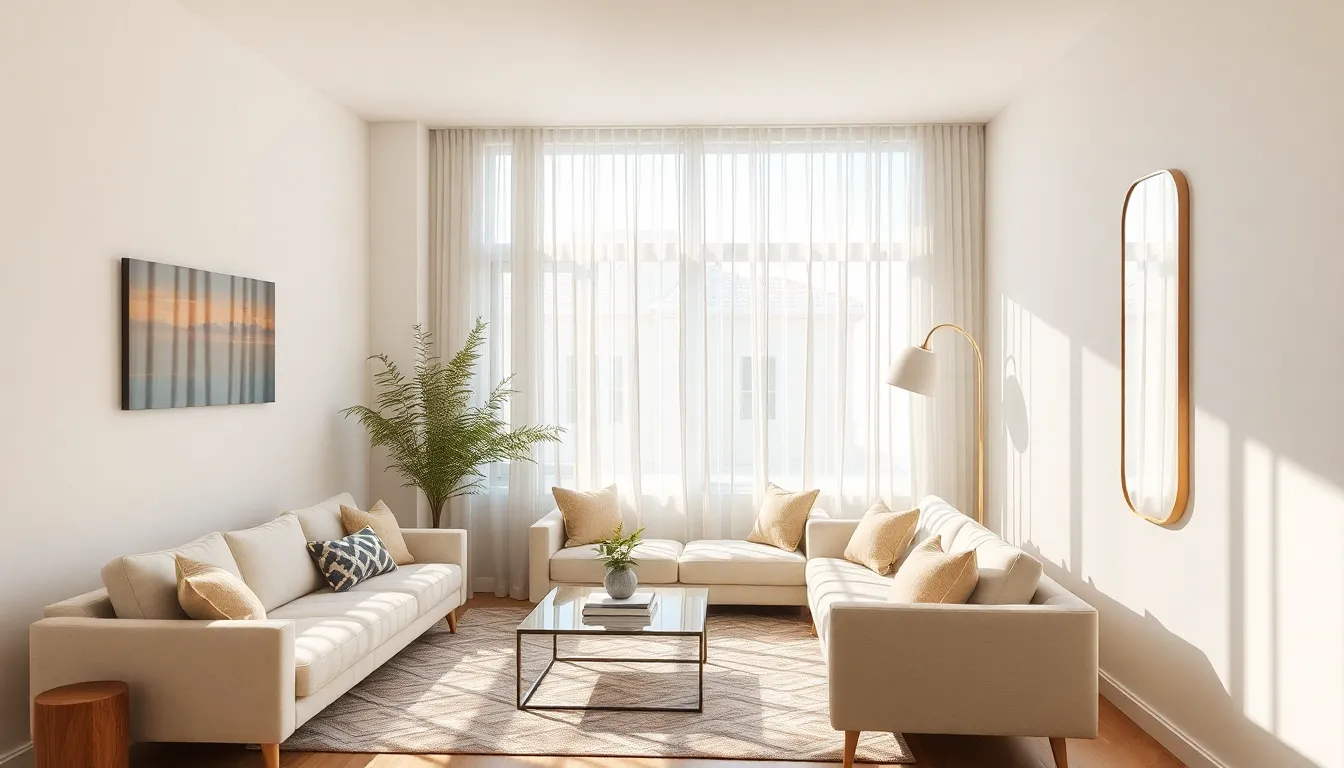
Natural light transforms cramped spaces into bright, welcoming environments that feel significantly larger than their actual square footage. We’ll show you how to harness every ray of sunlight to maximize your small living room’s potential.
Keep Window Treatments Minimal and Sheer
Window treatments should prioritize light infiltration over heavy coverage. Thin curtains allow sunlight to filter through while maintaining privacy during daytime hours. Sheer fabrics create an airy atmosphere without blocking the view outside your windows.
Blinds offer precise light control without overwhelming small spaces. We recommend choosing white or cream colored options that blend seamlessly with your walls. Vertical blinds work particularly well for narrow windows, while horizontal styles complement wider openings.
Avoid heavy drapes that consume precious wall space and block natural illumination. Floor to ceiling treatments make windows appear larger even when using lightweight materials. Consider mounting curtain rods closer to the ceiling rather than directly above the window frame.
Position Mirrors to Reflect Light Throughout the Space
Mirrors create the illusion of expanded square footage by reflecting natural light into darker corners. Place large mirrors directly opposite windows to double the amount of sunlight entering your room. This strategic positioning bounces light back and forth, creating a brighter atmosphere throughout the day.
Multiple smaller mirrors work effectively when arranged in groupings along walls. We suggest positioning them at eye level to enhance balance while reflecting light from various angles. Avoid placing mirrors where they’ll reflect clutter or unattractive views.
Mirrored furniture pieces serve dual purposes by providing functionality and light reflection. Coffee tables with mirrored tops, side tables with reflective surfaces, and mirrored cabinet doors all contribute to a brighter living space. These pieces maintain the room’s decorative appeal while maximizing light distribution.
Choose Light-Colored Furniture and Fabrics
Light colored furniture makes rooms feel more spacious and airy than darker alternatives. White, cream, and pale gray sofas reflect natural light rather than absorbing it like deeper tones. Beige and off white upholstery creates a clean backdrop that enhances the feeling of openness.
Fabrics in lighter shades contribute to an overall sense of brightness and space. We recommend selecting throw pillows, blankets, and curtains in whites, pastels, or neutral tones. These accessories add comfort without creating visual weight that makes small spaces feel cramped.
Wood furniture in lighter finishes enhances natural light reflection throughout your living area. Blonde oak, whitewashed pine, and natural maple pieces maintain warmth while keeping the space feeling open. Avoid dark woods like mahogany or walnut that can make small rooms feel closed in and shadowy.
Define Zones Without Walls in Open Floor Plans
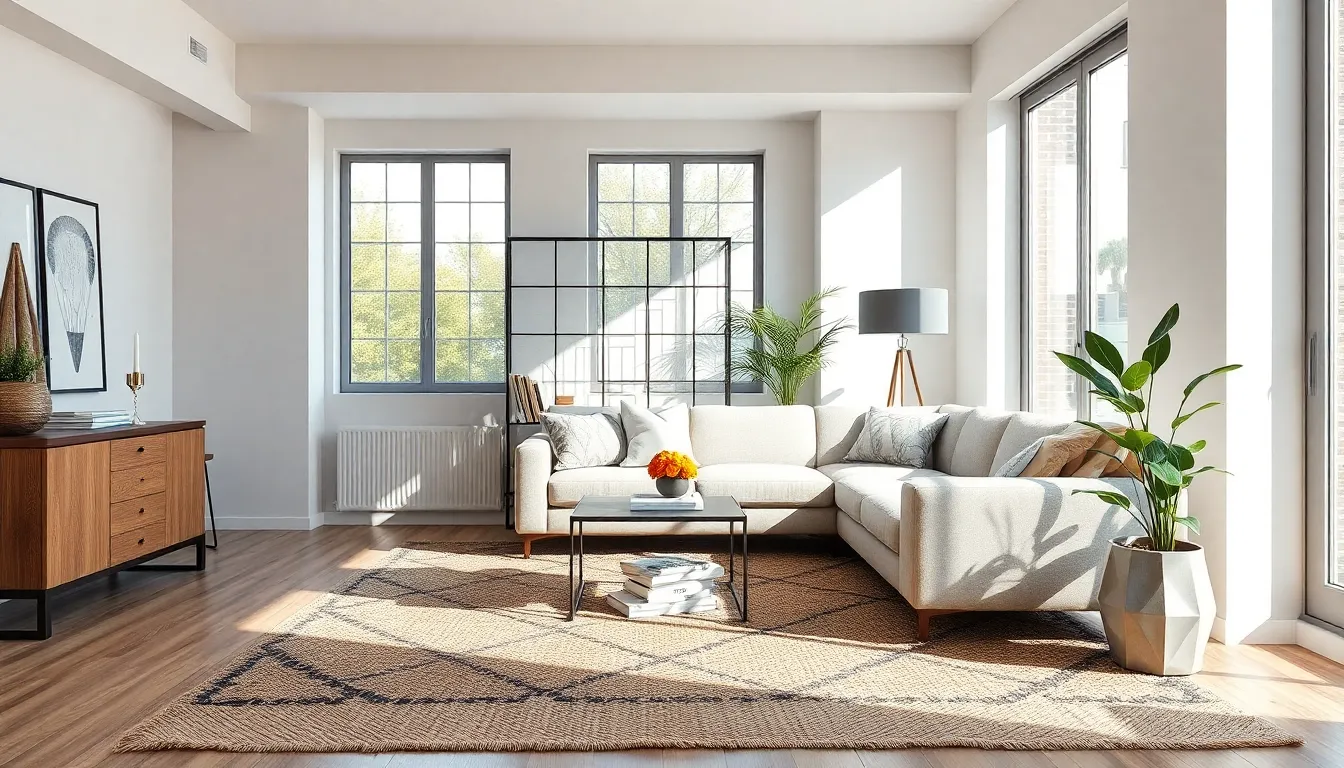
Open floor plans offer incredible flexibility but can leave us wondering how to create distinct living areas. We’ll show you how to establish separate zones that maintain the spacious feel while adding functional organization to your small apartment living room.
Use Area Rugs to Separate Living Spaces
Area rugs serve as invisible boundaries that visually separate different functional areas within your open living space. We recommend choosing rugs with similar colors or complementary patterns to maintain visual cohesion while creating distinct zones. Position a large rug under your seating area to anchor the conversation space and use a smaller accent rug to define a reading nook or workspace.
Texture becomes your secret weapon when selecting area rugs for zone definition. We suggest layering different textures—like a jute rug under a soft wool throw rug—to create depth and visual interest. Size matters significantly; ensure your furniture legs rest partially on the rug to properly ground each zone and avoid floating furniture that can make spaces feel disconnected.
Position Furniture to Create Natural Boundaries
Strategic furniture placement creates natural flow patterns that guide movement and establish clear boundaries between zones. We place our sofa perpendicular to walls rather than pushed against them to naturally separate the seating area from dining or workspace zones. Console tables positioned behind sofas work double duty as both storage and subtle room dividers.
Angle placement proves particularly effective in small spaces where every inch counts. We position chairs at slight angles to create intimate conversation areas while opening up walkways. Tall furniture pieces like bookcases or plant stands can serve as visual barriers without blocking light flow, maintaining the open feel while establishing distinct areas for different activities.
Install Room Dividers or Curtains for Privacy
Room dividers and curtains offer flexible privacy answers that can be adjusted based on your changing needs throughout the day. We favor ceiling height curtains that extend from floor to ceiling, making rooms appear taller while creating temporary walls when needed. Choose lightweight fabrics in neutral tones to maintain the airy atmosphere while providing visual separation.
Folding screens and geometric room dividers add architectural interest while serving practical purposes. We select pieces that complement our existing decor—wooden screens for warm, natural themes or metal geometric designs for modern aesthetics. These moveable answers let us reconfigure our space for entertaining guests or creating quiet work zones without permanent structural changes.
Choose Space-Saving Seating Solutions

We’ve found that smart seating choices can make or break a small living room’s functionality and flow. The right pieces maximize comfort while preserving precious square footage.
Select Armless Chairs and Compact Loveseats
Armless chairs create visual breathing room by eliminating bulky armrests that consume valuable space. We love positioning these streamlined pieces in tight corners or against walls where traditional armchairs simply won’t fit.
Compact loveseats serve as ideal focal points without overwhelming your apartment’s proportions. Choose models with exposed legs to maintain sightlines across the floor, creating an airier feeling throughout the room.
Consider swivel chairs that rotate to face different areas of your living space. These versatile pieces work double duty during conversations and entertainment without requiring multiple seating arrangements.
Consider Floor Cushions and Poufs
Floor cushions provide flexible seating that disappears when you don’t need them. Stack them in closets or slide them under coffee tables to keep pathways clear for daily living.
Poufs transform from footrests to coffee tables to extra seats depending on your needs. We recommend choosing firm options with flat tops that can safely hold drinks, books, and decorative items.
Storage poufs hide blankets, games, and seasonal items while serving multiple functions. Look for pieces with removable tops that reveal hidden compartments for apartment essentials.
Round poufs work better than square ones in tight spaces since they don’t have sharp corners. Position them strategically to create conversation areas without blocking natural traffic flow.
Use Built-In Seating Along Windows or Walls
Built-in seating maximizes every inch of available space by fitting snugly into alcoves and awkward corners. These custom answers often include hidden storage beneath the cushions for linens, books, and apartment clutter.
Window seats create cozy reading nooks while taking advantage of natural light. We suggest adding built-in bookshelves on either side to create a complete entertainment zone without additional furniture.
Banquette seating along walls eliminates the need for separate dining chairs in studio apartments. These space-efficient answers can accommodate more people than traditional seating arrangements while maintaining clean lines.
Corner built-ins use otherwise wasted space effectively. Design these L-shaped configurations with lift-up seats for maximum storage potential in your compact living area.
Incorporate Smart Storage Solutions Throughout
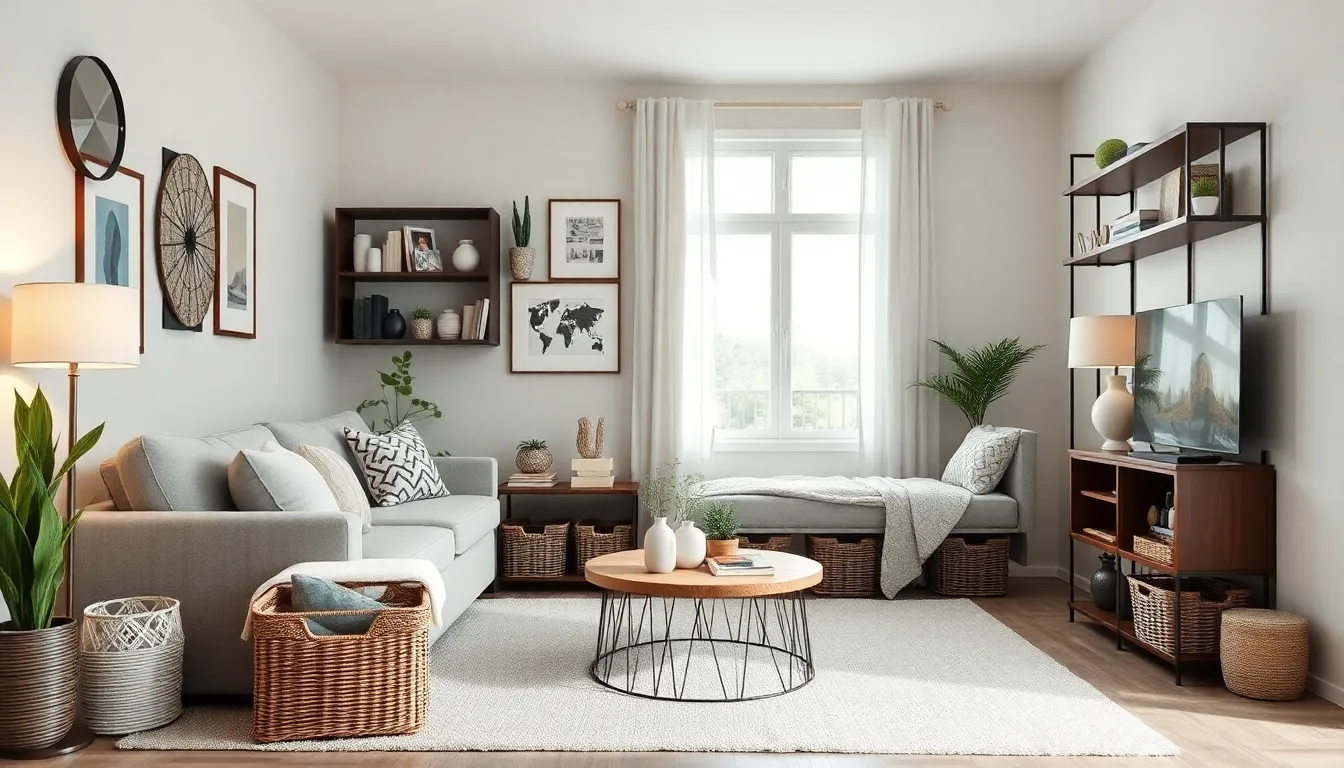
Smart storage transforms cluttered small living rooms into organized, functional spaces that feel twice their actual size. We’ll explore three essential storage strategies that maximize every square inch while maintaining your room’s aesthetic appeal.
Hide Clutter in Decorative Baskets and Boxes
Decorative baskets and boxes offer the perfect solution for concealing everyday items while adding visual interest to your space. We recommend placing woven baskets under console tables to store magazines, remote controls, and charging cables out of sight. Stylish storage boxes on shelves can hold seasonal decorations, extra throw blankets, or personal documents while serving as attractive decor elements.
Choose containers that complement your existing color scheme and materials. Natural wicker baskets work beautifully with neutral palettes, while sleek fabric boxes suit modern minimalist designs. Stack different sized boxes to create height variation on shelves, and label them discreetly for easy organization.
Use Under-Sofa Storage Containers
Under-sofa storage containers maximize hidden space that typically goes unused in small living rooms. These flat, rolling containers slide easily beneath most sofas and provide ample room for storing linens, out-of-season clothing, books, or board games. We suggest measuring your sofa’s clearance height before purchasing to ensure proper fit.
Clear plastic containers work best for visibility, allowing you to quickly identify contents without pulling them out completely. Fabric containers with handles offer easier access and blend seamlessly with your room’s aesthetic. Some containers feature wheels for effortless sliding, making access convenient even in tight spaces.
Install Corner Shelving Units
Corner shelving units transform wasted corner space into valuable storage and display areas. These vertical answers draw the eye upward while providing multiple levels for books, plants, decorative objects, or everyday essentials. We recommend floating corner shelves for a modern, streamlined look that doesn’t overwhelm small spaces.
Install shelves at varying heights to create visual interest and accommodate different sized items. Use the upper shelves for decorative pieces and the lower ones for frequently accessed items. Corner ladder shelves offer additional storage while maintaining an open, airy feel that’s perfect for small living rooms.
Add Visual Interest With Layered Lighting
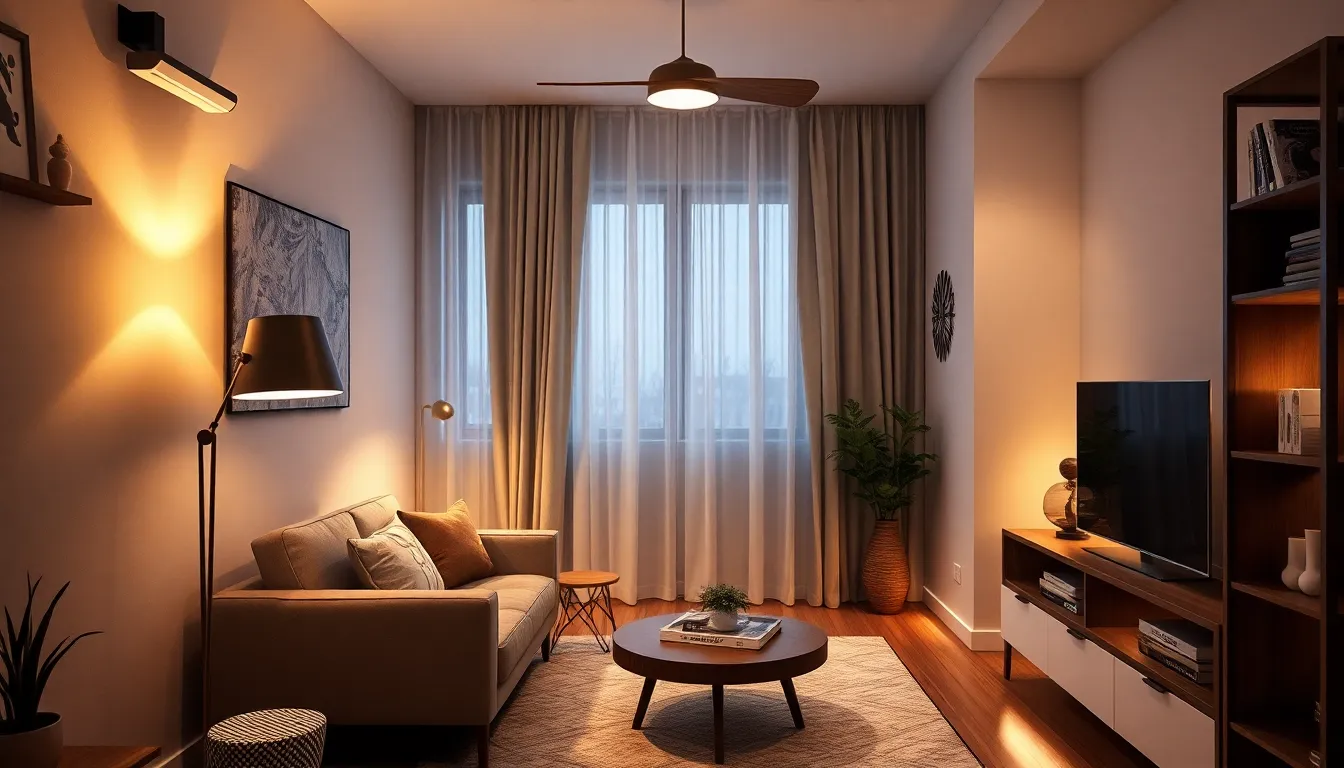
Creating depth and functionality in our small apartment living room requires thoughtful lighting design that goes beyond a single overhead fixture.
Combine Overhead, Task, and Ambient Lighting
Overhead lighting serves as our foundation, providing general illumination throughout the space. We’ll want to install ceiling fixtures like flush mounts or track lighting that don’t overwhelm our compact room. Task lighting targets exact activities such as reading or working, helping us maximize functionality in our multipurpose living area. Ambient lighting creates warmth and atmosphere, transforming our small space into a cozy retreat. This three layer approach ensures we have adequate brightness for daily activities while maintaining the flexible mood lighting that makes our apartment feel inviting.
Use Table Lamps and Floor Lamps Strategically
Table lamps work exceptionally well on side tables, console units, and floating shelves to highlight exact areas of our living room. Placing them near seating areas creates intimate conversation zones while adding visual weight to empty corners. Floor lamps maximize our vertical space without requiring additional furniture, making them perfect for small apartment living rooms. We should position these lamps behind sofas or beside armchairs to provide reading light while drawing the eye upward. Strategic placement of both lamp types creates multiple light sources that make our compact space feel larger and more ever-changing.
Install LED Strip Lights for Subtle Illumination
LED strip lights offer versatile ambient lighting options that enhance our small living room without taking up precious floor space. Installing them under furniture like coffee tables, floating shelves, or built in seating creates a gentle glow that makes our room feel more spacious. We can place these strips along baseboards to create the illusion of floating furniture while adding depth to our walls. Behind our television or along the back edge of console tables, LED strips provide eye comfortable backlighting that reduces glare during movie nights. This subtle illumination technique adds a modern touch while creating the cozy atmosphere that makes our apartment living room feel like home.
Scale Your Decor Appropriately for Small Spaces
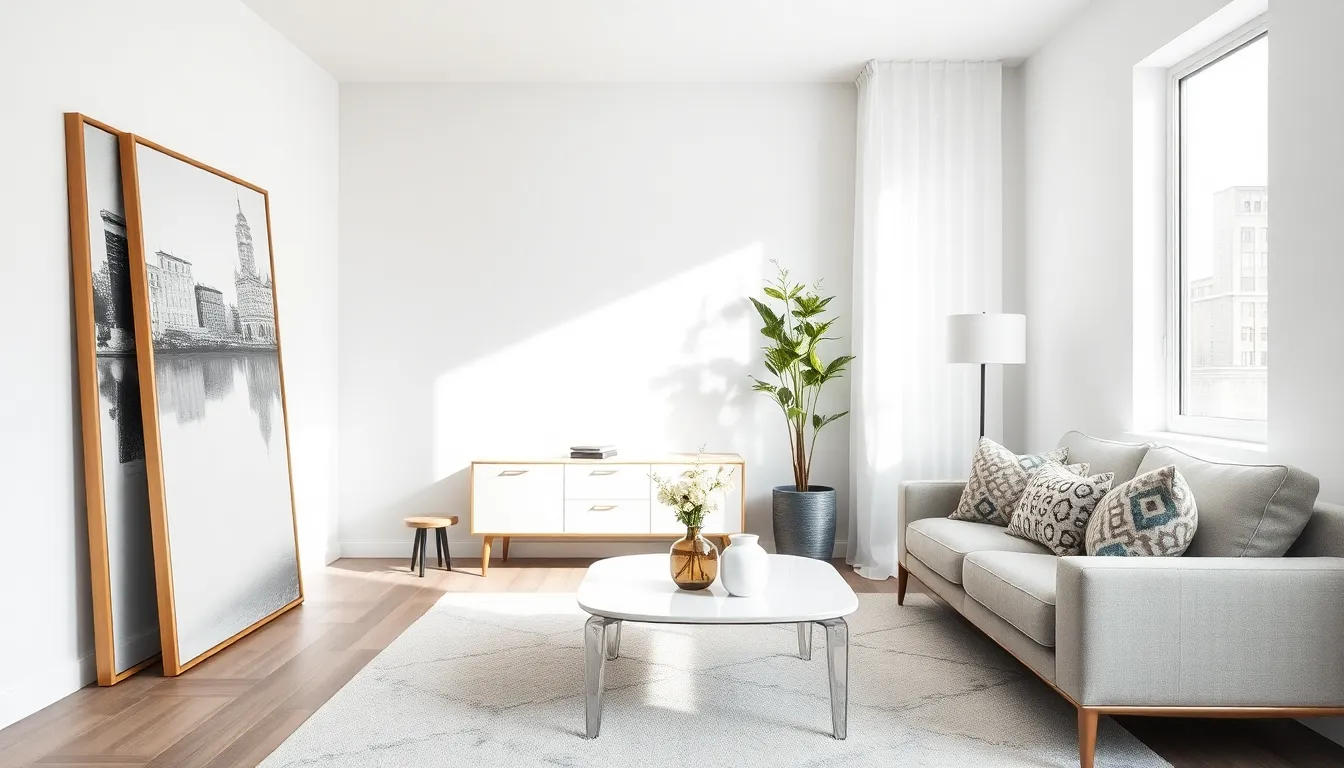
We’ve found that choosing the right scale for your apartment’s living room decor makes the difference between a cramped space and one that feels open and inviting. Proper proportions ensure every piece works harmoniously with your room’s dimensions rather than fighting against them.
Choose Fewer, Larger Statement Pieces
Selecting a few impactful decorative elements creates visual clarity while maximizing your space’s potential. We recommend investing in 2-3 substantial pieces like a large wall art collection, an oversized floor mirror, or a striking area rug instead of cluttering surfaces with many small accessories. Statement pieces command attention and establish focal points that draw the eye around the room naturally.
Large decorative elements also reduce visual noise that multiple small items typically create. Consider placing one oversized ceramic vase on your coffee table rather than several tiny figurines, or choose a single dramatic pendant light instead of multiple small fixtures. This approach maintains a clean aesthetic while allowing each piece to shine without competition from surrounding decor.
Avoid Overwhelming Patterns and Busy Designs
Limiting busy patterns prevents your small living room from feeling chaotic and visually cramped. We suggest incorporating no more than 2-3 patterns throughout the space, ensuring they share similar color palettes or design scales. Bold geometric prints on throw pillows can work beautifully when paired with subtle textures like woven blankets or smooth leather furniture.
Neutral tones create a calming foundation that makes your apartment feel more spacious and organized. Choose solid colors for larger pieces like sofas and curtains, then add patterned interest through smaller accessories like cushions or artwork. This strategy allows you to experiment with trends without overwhelming your space or committing to expensive patterned furniture that might quickly feel dated.
Select Furniture With Exposed Legs
Furniture with visible legs allows light to flow underneath, creating an illusion of openness that makes your living room appear larger. We recommend choosing sofas, chairs, and coffee tables that sit 6-8 inches off the floor, as this height provides optimal visual clearance while maintaining comfort and functionality. Exposed legs create negative space that tricks the eye into perceiving more room than actually exists.
Elevated furniture also makes cleaning easier and prevents dust accumulation underneath pieces. Look for mid century modern designs, Scandinavian styles, or contemporary pieces that feature sleek wooden or metal legs. These elevated designs work particularly well in studio apartments where maintaining sight lines across the entire space helps preserve the feeling of openness you’ve worked to create.
Conclusion
Creating a functional and stylish small living room doesn’t require magic—just smart planning and creative answers. We’ve shown you how multi-functional furniture storage answers and strategic color choices can transform your compact space into a comfortable haven.
Remember that every design decision should serve multiple purposes. Whether it’s choosing furniture with exposed legs or installing floating shelves your goal is maximizing both function and visual appeal. The key lies in thinking vertically using light effectively and selecting pieces that enhance rather than overwhelm your space.
With these proven strategies you’re ready to turn your small apartment living room into a space that feels both spacious and inviting. Start with one or two ideas that resonate most with your style and budget—you’ll be amazed at the transformation.
Frequently Asked Questions
What is the best furniture for small living rooms?
Multi-functional furniture is ideal for small living rooms. Choose storage ottomans, coffee tables with built-in drawers, expandable dining tables, and sofa beds. These pieces serve multiple purposes while saving space. Opt for furniture with exposed legs to create an airy feel and make cleaning easier.
How can I make my small living room look bigger?
Use light and neutral colors for walls and flooring to reflect natural light and create openness. Add large mirrors to reflect light and create depth. Keep window treatments minimal and sheer. Choose fewer, larger statement pieces rather than many small items to reduce visual clutter.
What colors work best in small living rooms?
Light and neutral color palettes work best as they enhance openness and reflect natural light. Use whites, creams, light grays, and soft beiges for walls and major furniture pieces. Add personality with colorful accessories like throw pillows and rugs without overwhelming the space.
How do I maximize storage in a small living room?
Utilize vertical space with floating shelves and wall-mounted units. Use decorative baskets and boxes to conceal items while adding visual interest. Consider under-sofa storage containers and corner shelving units. Built-in seating with hidden storage compartments also maximizes functionality while saving space.
What lighting works best for small living rooms?
Layer your lighting with a combination of overhead, task, and ambient lighting. Use table and floor lamps strategically to create intimacy without taking up floor space. LED strip lights provide subtle illumination while saving space. This approach creates depth and makes the room feel larger.
How can I create separate zones in a studio apartment?
Use area rugs to visually separate different functional spaces while maintaining cohesion with complementary colors. Strategically place furniture at angles to create natural boundaries. Consider lightweight room dividers or curtains for flexible privacy solutions that don’t permanently divide the space.
What seating options work well in small spaces?
Choose armless chairs and compact loveseats to maximize comfort while preserving space. Swivel chairs offer versatile arrangements. Floor cushions and poufs provide flexible seating that can be easily stored. Built-in seating along windows or walls utilizes awkward spaces effectively while offering hidden storage.
Should I use vertical space in my small living room?
Yes, utilizing vertical space is crucial in small living rooms. Install floating shelves and tall bookcases that draw the eye upward, creating the illusion of higher ceilings. Hang artwork and mirrors at eye level for balance. This approach keeps floors clear and creates an airy feeling.

